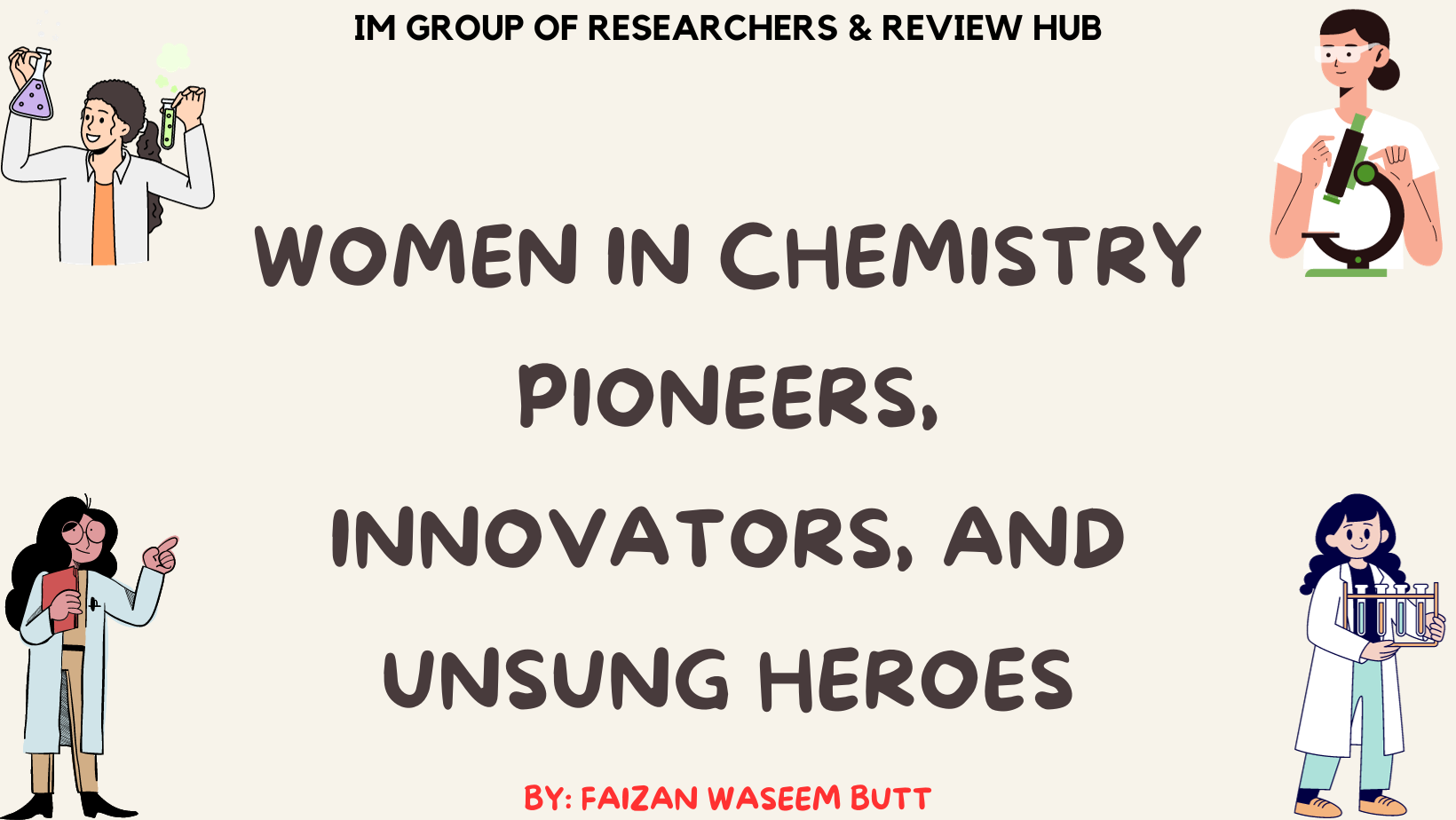Women in Chemistry: Pioneers, Innovators, and Unsung Heroes
Women in Chemistry: Pioneers, Innovators, and Unsung Heroes. The field of chemistry has made significant strides thanks to the extraordinary contributions of female scientists across the annals of history. Despite the frequent undervaluation of their achievements, often overshadowed by those of their male peers, women have been instrumental in broadening our understanding of the natural world. They have made lasting impressions on the discipline. In this article, we embark on a journey to explore the narratives and achievements of several of the most influential female chemists, shedding light on their remarkable work, unswerving dedication, and the hurdles they surmounted.
Author
Faizan Waseem Butt

Maria Skłodowska Curie: The Pioneer of Radioactivity
Marie Curie, born in 1867, was a groundbreaking figure in the world of chemistry. She was not only the first woman to win a Nobel Prize but also the first person to win Nobel Prizes in two different scientific fields—physics and chemistry. Her pioneering work on radioactivity revolutionized our understanding of atomic structure and paved the way for developments in nuclear physics and medicine.
Curie’s most notable discovery was radium and polonium, two highly radioactive elements. Her tireless dedication to research, often conducted under challenging conditions, led to the development of mobile radiography units during World War I, commonly known as “Little Curies.” These units saved countless lives by allowing doctors to diagnose injuries more quickly and accurately.
Marie Curie’s groundbreaking work in the field of radioactivity earned her recognition as a true pioneer in chemistry and a source of inspiration for women in the sciences to this day.
Dorothy Crowfoot Hodgkin: The Queen of Crystallography
Dorothy Crowfoot Hodgkin, born in 1910, was a British chemist who became renowned for her contributions to X-ray crystallography. Her groundbreaking work in this field allowed scientists to determine the three-dimensional structures of complex molecules, a vital tool in understanding the structures of proteins and other organic compounds.
Hodgkin’s most celebrated achievement was the determination of the structure of penicillin, which marked a significant advancement in our understanding of antibiotics and their applications. She later used X-ray crystallography to determine the structures of important biomolecules, including insulin and vitamin B12.
Her remarkable contributions earned her the Nobel Prize in Chemistry in 1964, making her the third woman to receive this prestigious honor. Hodgkin’s dedication to crystallography continues to influence modern drug design and the study of molecular biology.
Rosalind Franklin: DNA’s Unsung Heroine
While Rosalind Franklin’s name is often overshadowed by the discovery of the DNA double helix, her contributions to the understanding of DNA’s structure were indispensable. Born in 1920, Franklin’s work in X-ray crystallography provided key insights into the structure of DNA.
Franklin’s famous “Photograph 51” captured the image of DNA fibers and was critical in revealing the helical structure of DNA. Her data and analysis were crucial to James Watson and Francis Crick’s formulation of the DNA double helix model. Unfortunately, Franklin did not receive the recognition she deserved during her lifetime.
Franklin’s work had a profound impact on molecular biology, and her contributions continue to be celebrated today as a vital component of the discovery of DNA’s structure.
Alice Ball: The Unsung Hero of Leprosy Treatment
Alice Ball, born in 1892, was an African American chemist whose work had a profound impact on the treatment of leprosy. Ball’s pioneering research focused on developing an injectable and more effective treatment for this debilitating disease.
She is best known for the development of the “Ball Method,” a technique for making the active ingredient in the treatment of leprosy, known as chaulmoogra oil, soluble in water. Her method made it possible to create an injectable treatment, which was significantly more effective and less painful for patients suffering from leprosy.
Tragically, Alice Ball’s life was cut short at the age of 24, but her contributions to the treatment of leprosy live on. Her method became the standard treatment for leprosy for several decades, saving the lives and improving the quality of life for countless individuals.
Stephanie Kwolek: The Creator of Kevlar
Stephanie Kwolek, born in 1923, was an American chemist who made a lasting impact on the field of material science. Her invention of Kevlar, a strong and lightweight synthetic fiber, has had numerous applications, particularly in the field of personal protective equipment and body armor.
Kwolek’s groundbreaking discovery came during her work at DuPont, where she was researching new materials for tires. She stumbled upon a compound that exhibited remarkable strength and heat resistance. This accidental discovery led to the creation of Kevlar, a material five times stronger than steel by weight.
Kevlar is widely used in bulletproof vests, helmets, and various other protective gear, helping save countless lives. Kwolek’s innovation in material science demonstrates the vital role women have played in pushing the boundaries of chemistry and technology.
Chien-Shiung Wu: The First Lady of Physics
While Chien-Shiung Wu was primarily a physicist, her contributions to the field of nuclear physics had a profound impact on chemistry as well. Born in 1912 in China, Wu was a trailblazer in her field and played a pivotal role in experimental research.
Wu’s most famous experiment, the “Wu Experiment,” proved the theory of parity violation in weak nuclear interactions. This experiment had far-reaching implications for the field of nuclear physics and contributed to our understanding of particle physics.
Her work influenced both physics and chemistry, and Wu’s accomplishments continue to inspire women in science and serve as a testament to the critical role women have played in advancing our knowledge of the physical and chemical world.
Ellen Swallow Richards: A Pioneer in Environmental Chemistry
Ellen Swallow Richards, born in 1842, was a pioneering figure in environmental chemistry and home economics. She was the first woman admitted to the Massachusetts Institute of Technology (MIT) and went on to become the institute’s first female instructor.
Richards’ work focused on water quality, sanitation, and nutrition. She conducted extensive research on water purification and developed innovative techniques for analyzing water quality. Her contributions in this field laid the groundwork for modern environmental chemistry and public health.
Ellen Swallow Richards was a tireless advocate for women’s education and played a significant role in opening doors for women in STEM fields. Her legacy is a testament to the impact women can have on the intersection of chemistry and environmental science.
Alice Hamilton: A Vanguard in Occupational Medicine
Alice Hamilton, an American physician, and toxicologist made substantial contributions to occupational medicine. She conducted groundbreaking research on the health hazards of industrial chemicals and tirelessly strove to enhance workplace safety standards. Hamilton’s work led to the adoption of safer practices in industries, safeguarding the health of countless workers.
Rita Levi-Montalcini: A Trailblazer in Neurochemistry
Rita Levi-Montalcini, born in 1909, was an Italian neurologist and biochemist whose pioneering work on nerve growth factor (NGF) transformed our understanding of the nervous system. Her research focused on the growth and development of nerve cells.
Levi-Montalcini’s discovery of NGF, a protein that promotes the growth and survival of nerve cells, had profound implications for both neuroscience and cell biology. Her work opened up new avenues for studying the development and regeneration of the nervous system.
In recognition of her groundbreaking research, Rita Levi-Montalcini received the Nobel Prize in Physiology or Medicine in 1986, becoming the sixth woman to be awarded this prestigious honor.
Fanny Hesse: The Creative Force Behind Agar Culture
Fanny Hesse, a German-American microbiologist, is credited with inventing agar-agar as a culture medium. This contribution revolutionized microbiology, allowing for the cultivation and study of microorganisms, a practice still widely employed in laboratories today.
Challenges Faced by Women in Chemistry
Throughout history, female chemists encountered myriad challenges, including limited educational opportunities, exclusion from professional societies, and gender discrimination. Despite these hurdles, the women mentioned in this article persisted, achieving significant breakthroughs in their respective domains, and serving as ongoing sources of inspiration for future generations of female scientists.
Conclusion
The field of chemistry has benefited significantly from the remarkable and varied contributions of women. These contributions span from pioneering research in areas such as radioactivity and crystallography to groundbreaking discoveries in materials science and drug development. Women have, without a doubt, played a crucial role in advancing our comprehension of the physical and chemical realm.
These accomplished women, among numerous others, have effectively illustrated that gender should never serve as an impediment to scientific accomplishment. They have not only left an indelible mark on the realm of chemistry but have also dismantled barriers, thereby paving the path for forthcoming generations of women to embark on careers in science.
While we commemorate the achievements of these exceptional women, we must also underscore the significance of nurturing an inclusive and diversified scientific community. This is one where individuals from all backgrounds are empowered to contribute to the advancement of knowledge. Women in the field of chemistry, like these pioneers, continue to serve as a source of inspiration. They underscore the fact that the world of science thrives and flourishes when it encompasses the perspectives and contributions of all individuals, irrespective of gender.
Also Read: Chitosan-Based Hydrogel: An Eco-Friendly Solution for Wastewater Treatment
Follow Us on

